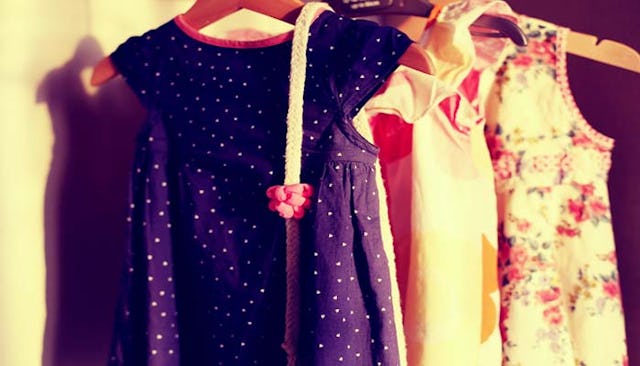Dad's Rant About The 'Apparently Immoral' Shoulders Of His 5-Year-Old Is Right On

It’s not news that school dress codes tend to be overwhelmingly sexist, a quick look at one will usually mean reading paragraphs worth of directives for girls and a small mention of what is appropriate for boys. But is it taking it a little too far to cover up the shoulders of a five-year-old who showed up to school in a spaghetti strap dress?
When Jef Rouner picked his five-year-old up from school last week, he wasn’t expecting to see her emerge from the campus wearing a t-shirt over the sundress she wore to school. He certainly wasn’t expecting her to be wearing her jeans underneath. He had packed an extra set of clothes unless it got chilly, but she had her heart set on wearing a new sundress to school, so he acquiesced.
The school district’s dress code specifically mentions spaghetti strap dresses: “Students are not to wear clothing that is tight, loose, sagging, baggy, revealing, spaghetti-strap, backless, low cut or short.” But Rouner didn’t expect this would be something that would be enforced for a five-year-old. He says in a blog post about the experience in the Houston Press, “Make no mistake; every school dress code that is not a set uniform is about policing girls and girls alone.” It’s easy to say that this is a parent who just didn’t follow the rules and for that reason his five-year-old was forced to cover up. But his questioning of the dress code is valid, because if you really look at it, it’s so vague that it could honestly be used to shame girls at the discretion of whatever administrator is in charge of such decisions.
Here are some other bullet points of the dress code, and they are very similar to those in many different schools across the country:
Shorts and Skirts – must be fitted at the waist or upper hip, must not reveal underclothing, and must be mid-thigh in length or longer
Tops, Shirts and Blouses – must not reveal underclothing, midsection, torso, back, chest, breasts or cleavage
Dresses – must not reveal underclothing, midsection, torso, back, chest, breasts, or cleavage and must be mid-thigh in length or longer
These may seem like reasonable requests, but if you really look at them they leave very few options for girls. Especially the shirts, which “must not reveal underclothing, midsection, torso, back, chest, breasts or cleavage.” So what’s left for girls? Turtlenecks or high crew-neck t-shirts? How many of the shirts in your closet don’t show a glimpse of your back, chest, or an errant bra-strap?
As a girl who developed early, I can attest to the fact that the same exact outfit will look completely different on two different bodies. My childhood best friend with her long legs, slim build and absence of any boobs whatsoever could look more “modest” in the same outfit I wore simply because she didn’t have breasts and cleavage to show. I’ve had curvy hips since I was seven years old. Clothes have always just fit “tighter” because kids’ clothes especially don’t account for bodies that need more room. Why are we making young girls feel like glimpses of their female form are totally shameful? Covering up the shoulders of a five-year-old? Rouner says, “The continued fascination of people that a girl with too much skin showing, or who develops breasts early or any number of other things is somehow opening the door to everything from commentary about her purity to outright assault is in no danger of going away.”
He’s right. A handful of stories over the past year support it. There was the story of almost 200 girls given detention because their New Jersey high school (that doesn’t have air-conditioning) changed the dress code to prohibit tank tops. A few months ago a Utah student was banned from wearing a dress that showed her partially exposed shoulders to a high school dance. In May of last year 30 female students were sent home from a Canadian high school because you could see a glimpse of their bra straps under their tank tops.
Rouner is right to question a dress code that reprimands our daughters for showing the tiniest glimpses of their bodies from such a young age. We should all be questioning why exactly we feel the need to police the way our daughters look with such a vengeance.
This article was originally published on